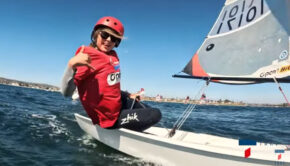Moving the Ball to the End Zone
Published on July 5th, 2017
Kimball Livingston, who was the 2016 commodore of St. Francis Yacht Club (San Francisco, CA), led an initiative that changed the focus of his club’s youth program.
The club was eager to see its youth program develop lifelong sailors and active club members, but recognized it was investing heavily into High School Sailing and not alternative paths that could extend beyond the school years, and potentially deliver more reward to more sailors.
So StFYC launched a new plan (click here), emphasizing High School Sailing during the fall season only, and changing the focus in the spring. Kimball explains how they moved the ball to the end zone.
When St. Francis Yacht Club decided to go it alone and run our future High School Sailing in fall semesters only, we took a deep breath. But our sailing director, Brent Harrill, said do it. Our head coach, Adam Corpuz-Lahne, said do it. Other high school sports run one semester only, and our numbers always dip in the spring and —
As soon as our people understood that we are taking away in order to add, and we will now have spring-season opportunities in boats more capable than the FJs that California uses in our standardized “High School Sailing” format, and we’re bringing in boats that teach higher-level skills with more variety and more clinics, and we want to build complete sailors—once they got that, they were all-in.
Something worth knowing: Before we pulled the trigger, St. Francis met with five other clubs that run the bigger high school programs in Northern California, and together we asked our representatives at BAYS, Bay Area Youth Sailing, to revise the calendar for 2017-18.
All our coaches (and did I mention all, and they’re also the directors of BAYS) were telling us that standard high school sailing (tacking and gybing FJs) ate them alive at the expense of every other experience they could be offering our kids.
We told them to go for what they wanted: fewer “high school regattas,” more practice days relative to racing, and changes allowing non-ranking regattas to include additional classes. Was that weird? Oh baby. We were asking the people who work for us to do what they were telling us they wanted to do, and even at that, the meeting ran two hours and we still, still, still weren’t sure what would come next.
Readers familiar with the longtime constipation in these matters will be surprised that when BAYS negotiated the calendar with the Pacific Coast Interscholastic Sailing Association, they got most of what they asked for. That moved the ball.
StFYC deliberated, decided we were on a roll, and we’d keep rolling.
Whether in FJs or 420s, many of the best teenage sailors in America participate in “high school sailing” and it’s a good thing. Much time and effort have gone into making high school sailing what it is today. At StFYC it brings in new people, teaches them to sail and affords a tremendous coed social experience. But it’s not how the best become the best.
Not every region shares our problems, but I’ve heard people from colder climes suggest sailing the Nationals in the fall, when their teams are up and running, instead of spring when they’re scrambling to launch boats on thawing water. StFYC kept the fall semester because that’s when we get newcomers inspired by summer sail camps or perhaps intrigued by an offering in the freshman catalogue, something they hadn’t thought about before . . .
Our St. Francis poster boy is a 14-year-old who came to the sport last year as a curious freshman. He bucked up the courage to take sailing lessons alongside 8-year-olds to earn a shot at making his school’s JV team, and when he made it, he was thrilled. By the end of the first semester, however, his enthusiasm for FJs was wearing thin. Not his newfound passion for sailing, mind you.
And so it went as he sailed through the spring semester, completed his year of high school sailing, and then transitioned to our programs and clinics in C420s, J/22s and Nacra catamarans. Suddenly the mojo was back. The young man decided that, going forward, he would join just one semester of high school sailing and then somehow – he had no idea how – find a way to sail faster, more challenging boats.
Then we announced the new order, and let’s give Jonah a name because he’s a real person, and now we have our Jonah telling us, “You solved my problem. Thank you. Thank you.”









 We’ll keep your information safe.
We’ll keep your information safe.